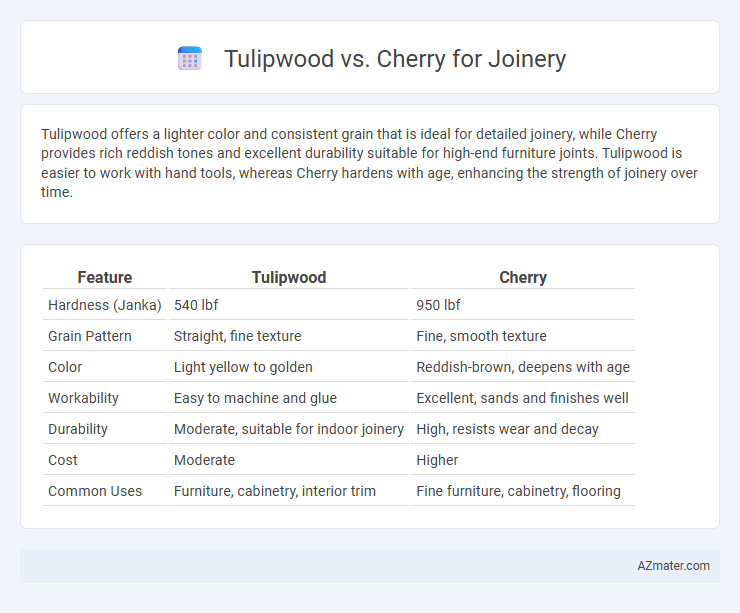Tulipwood offers a lighter color and consistent grain that is ideal for detailed joinery, while Cherry provides rich reddish tones and excellent durability suitable for high-end furniture joints. Tulipwood is easier to work with hand tools, whereas Cherry hardens with age, enhancing the strength of joinery over time.
Table of Comparison
| Feature | Tulipwood | Cherry |
|---|---|---|
| Hardness (Janka) | 540 lbf | 950 lbf |
| Grain Pattern | Straight, fine texture | Fine, smooth texture |
| Color | Light yellow to golden | Reddish-brown, deepens with age |
| Workability | Easy to machine and glue | Excellent, sands and finishes well |
| Durability | Moderate, suitable for indoor joinery | High, resists wear and decay |
| Cost | Moderate | Higher |
| Common Uses | Furniture, cabinetry, interior trim | Fine furniture, cabinetry, flooring |
Introduction to Tulipwood and Cherry
Tulipwood is a lightweight hardwood known for its pale yellow to reddish-brown hues and fine grain, commonly used in fine joinery and veneer work due to its smooth finish and ease of machining. Cherry wood, prized for its rich reddish-brown color and smooth texture, offers excellent durability and ages gracefully, making it a favorite for high-end cabinetry and furniture joinery. Both woods provide distinct aesthetic qualities and workability, with tulipwood favored for its uniform appearance and cherry valued for its warm tones and natural aging process.
Botanical Origins and Wood Characteristics
Tulipwood, derived from the Liriodendron tulipifera tree native to North America, features a pale yellow to light green hue with a fine, straight grain, providing a smooth surface ideal for detailed joinery work. Cherry wood, sourced from Prunus serotina, also indigenous to North America, is characterized by a rich reddish-brown color that deepens with age and a fine, even texture that offers excellent workability and a warm aesthetic. Both woods are prized in fine woodworking, with tulipwood favored for its stability and subtle grain patterns, while cherry is valued for its durability and natural lustrous finish.
Color and Appearance Differences
Tulipwood exhibits a distinctive pale yellow to light pink hue with subtle, straight grain patterns, offering a modern and clean aesthetic for joinery projects. Cherry wood, on the other hand, features a rich reddish-brown color that deepens and darkens over time, enhancing warmth and elegance in furniture and cabinetry. The color stability and fine, smooth texture of cherry make it ideal for classic, high-end joinery contrasted with tulipwood's lighter and more contemporary look.
Workability in Joinery Applications
Tulipwood offers excellent workability in joinery due to its fine, straight grain and moderate hardness, facilitating precise cuts and smooth finishes without excessive wear on tools. Cherry wood, valued for its uniform texture and natural oils, provides superior machinability and strong glue adhesion, making it ideal for intricate joinery details and fine craftsmanship. Both woods respond well to chiseling and sanding, but Cherry's dimensional stability reduces the risk of warping in assembled joints over time.
Strength and Durability Comparison
Tulipwood offers moderate strength and good workability, making it suitable for lightweight joinery projects, but it is less dense and durable compared to cherry wood. Cherry wood exhibits superior hardness, strength, and resistance to wear, which enhances the longevity and stability of joinery structures. For applications requiring long-term durability and structural integrity, cherry is generally preferred over tulipwood.
Finishing and Staining Properties
Tulipwood offers a pale yellow to light brown base that readily accepts stains, enhancing its natural grain during finishing, while cherry wood presents a rich reddish-brown hue that deepens with age and exposure, requiring careful staining to preserve its warmth without blotching. Both woods respond well to oil and lacquer finishes but cherry's fine, closed grain allows for a smoother, more polished final surface compared to the coarser tulipwood. Choosing between tulipwood and cherry for joinery hinges on the desired aesthetic effect, as tulipwood's staining versatility suits varied finishes, whereas cherry's natural color often thrives with minimal staining to highlight its characteristic patina.
Cost and Availability
Tulipwood offers a more affordable option for joinery compared to cherry, with prices generally ranging from $2 to $4 per board foot, while cherry typically costs between $6 and $9 per board foot. Tulipwood is widely available, especially in North America, due to its fast growth and abundant supply, making it easier to source for large projects. Cherry's slower growth and higher demand result in limited availability and premium pricing, suitable for high-end or detailed woodworking projects.
Environmental Impact and Sustainability
Tulipwood, known for its rapid growth in North American forests, offers a more sustainable option for joinery compared to cherry wood, which grows slower and is often sourced from older, less renewable forests. Tulipwood's lower environmental impact stems from responsible harvesting practices and its ability to regenerate quickly, reducing deforestation pressure. Cherry wood, while prized for durability and color, tends to have a higher ecological footprint due to longer growth cycles and less widespread sustainable certification.
Common Uses in Furniture and Joinery
Tulipwood is prized for its vibrant color and smooth grain, making it ideal for decorative veneers, cabinetry, and intricate joinery work in furniture. Cherry wood offers exceptional durability and a rich, warm tone that deepens with age, commonly used in high-end furniture, chair frames, and detailed moldings. Both woods excel in joinery but tulipwood is favored for aesthetic highlights while cherry is chosen for structural elements requiring strength and long-lasting appeal.
Choosing the Right Wood for Your Project
Tulipwood offers a lightweight yet strong option with a pale yellow to golden hue, ideal for decorative joinery requiring fine, smooth finishes. Cherry wood provides superior durability and a rich reddish tone that deepens with age, making it perfect for heirloom-quality furniture and pieces exposed to wear. Selecting between tulipwood and cherry depends on project demands for color, grain, strength, and aging characteristics to achieve the desired aesthetic and functional outcomes.

Infographic: Tulipwood vs Cherry for Joinery
 azmater.com
azmater.com